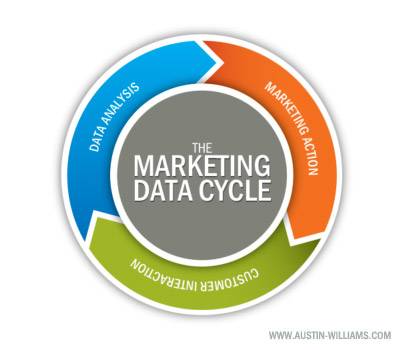As the world of digital marketing becomes more complex, consumers are generating huge amounts of data and marketers are able to get more of it. So much, in fact, that many marketers find themselves drowning in it. Data and measurement are no longer about the end result of your marketing; they’re about understanding customer behavior and making smarter decisions at the beginning. Ready to dig in?
This data comes from all corners of your brand—your marketing initiatives, retail spaces, websites, customer service reps and even your sales team. Data can come in the form of brand mentions from Facebook and Twitter or from collected conversations around a much more basic topic. Data can come from website analytics in the form of tracking conversions, clicks, bounce rates, search keywords and more. It can also come from search and display ads; analyzing which headlines, creative and calls to action are resulting in more clicks and conversions. Forms also play a role in collected specific information from those who interact with your websites. Names, email addresses, physical addresses—these are also forms of data.
Getting Buried Yet?
Tracking a customer purchase from start to finish is not as straightforward as many marketers believe. Let’s say a customer searches for gold watches on Google and lands on your website. He finds a watch, but is not ready to buy it yet. A week later, he goes directly to your website and purchases the watch. Many measurement platforms will attribute this sale to direct traffic when it really belongs to search. It’s also possible that the customer’s search was influenced by banner ads he saw a week prior to searching. How much of that sale is attributed to the banner ads versus search?
In today’s fragmented media landscape, it is possible that search, social media, display ads, word-of-mouth and traditional advertising can all contribute to—and influence—a sale.
The other challenge in tracking a purchase or action from start to finish is when the path is broken. Banks and credit unions work with a lot of third party tools, which can make it difficult to track the customer from point A to point B to point C. The B2B sales cycle also tends to be longer than the B2C sales cycle, requiring tracking a customer’s behavior for three months when the customer interacts with the brand through so many touch points.
Data Is Pointless Until You Make It Valuable
The data you collect through analytics, AdWords and other sources is pointless. Pointless, that is, until you are able to leverage it to increase the effectiveness of your marketing or create better customer experiences. Turning the data into something valuable depends completely on your marketing team’s ability to extract the relevant data, suggest ways to improve performance and properly implement changes to your marketing tactics.
The Data Cycle
As mentioned above, there are many marketers who see data as the end result; a final measurement of how well a campaign or tactic is going. In reality, this is a circular process:

1. Data Analysis. Find the right data and analyze it to better understand how your customers are interacting with your brand. What are they buying? Where are they buying it from? How are the mobile interactions different? How are they using your website? How are they getting there? Why are they leaving? These are just a few basic questions, but you’ll be surprised by how many marketers don’t know the answer.
2. Marketing Action. Based on your data analysis, you’ll discover insights that will help you make some key marketing decisions. Changes in calls-to-action, improvements made to your retail experience or even adjusting the emphasis on one product feature over another can lead to better customer interactions with your brand.
3. Customer Interaction. See how the changes made to your website or marketing tactic changed the way customers are interacting with your brand. As your customers interact with you, they are giving you new data to analyze.
In the end, looking at all of the data is too much for anyone. Each piece of data tells you a different story and can spark different ideas that lead to unique decisions. First determine which pieces of data mean the most to your bottom line and relate directly to your strategy. Focus on just those pieces and you’ll be able to keep your head above the water and move the needle in the right direction.
What is your data telling you? Are you using data to change the way you market your products and services? Tell us about it in the comments.








